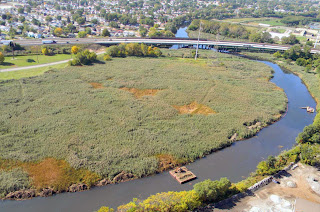“Work will start April 22 on a project that will dredge (remove) or cap (isolate from the ecosystem) 1.2 million cubic yards of river bottom sediment contaminated with PAHs, oil & grease, PCBs, and heavy metals like cadmium and copper. Volume-wise, this would fill about 300 Olympic-sized swimming pools. Along with restoration of more than 50 acres of wetland habitat, this work will take place for approximately three years from Kennedy Ave to Cline Ave…This work is funded by US Environmental Protection Agency, Indiana Department of Environment, and Indiana Department of Natural Resources, in partnership with US Fish and Wildlife Service, The Nature Conservancy, Shirley-Heinze Land Trust, Save the Dunes, municipalities, and other local and federal partners. The US Army Corps has also begun dredging in the Indiana Harbor and Ship Canal, and is on track to dredge 300,000 cubic yards through August this year.”
Category:
New section of Grand Calumet river restoration work begins
May 6th, 2013 by Irene MilesIISG’s Caitie McCoy presents Great Lakes progress at international conference
February 18th, 2013 by Irene MilesIISG’s Caitie McCoy attended the Seventh International Conference on Remediation of Contaminated Sediments last week to present her community outreach work with the Great Lakes Legacy Act (GLLA). The conference traditionally features environmental scientists and engineers, but that is changing. “We are starting to see more attention paid to community engagement at these types of conferences,” Caitie tells us. “Technical project managers realize that projects are easier to implement when the community understands and supports the work, and so they’re eager to learn from professionals who specialize in community engagement and stakeholder involvement.”
Caitie presented a poster on her educational program in northwest Indiana, which taught students about the GLLA sediment cleanup at Roxana Marsh on the Grand Calumet River. Instead of presenting a typical scientific poster full of text and graphs, Caitie displayed a mural that her fourth grade students made to represent the Roxana Marsh ecosystem.
“Some of my colleagues were a bit skeptical about me presenting a fourth grade mural to a bunch of technical folks, but I’m not afraid to shake things up,” Caitie said. “I wanted to use something eye-catching that would draw people’s attention toward my poster.” And it worked. Caitie was visited non-stop during the session and talked to more than 100 conference attendees about her program. When asked if she thought her poster made an impact, Caitie replied, “I would never have dreamed that someday engineers would be asking me how to replicate my educational program at their sites, so I take that as a big success.”
 Caitie will expand her programming throughout the Grand Calumet River community in 2013, as the Legacy program begins another phase of dredging this summer.
Caitie will expand her programming throughout the Grand Calumet River community in 2013, as the Legacy program begins another phase of dredging this summer.
Wisconsin students learn about Great Lakes cleanup
December 10th, 2012 by Irene MilesCaitie writes, “I visited Sheboygan, Wisconsin last Tuesday and spoke to high school biology students, answering questions about the Great Lakes Legacy Act dredging project happening just two miles from their school. This was my final school to visit in Sheboygan as part of a 12-school, countywide tour, which began this past October and reached about 600 high school science students. Now the students know the purpose of a cleanup happening right in their downtown, and they understand the science behind it.

This project is part of a larger effort to provide students with stewardship opportunities and supplemental hands-on education about remediation and restoration efforts throughout the Great Lakes. It has been great to work with students in Sheboygan and Northwest Indiana, and I look forward to bringing this program to more Great Lakes students soon.”
Recent News
IISG Instagram
✨ Start Your New Year with Great Lakes Learning! ✨
Kick off 2026 by exploring the Center for Great Lakes Literacy Resource Library. It’s your one-stop hub for lesson plans, activities, and tools to bring Great Lakes science into your teaching setting.
Visit the link in bio to dive in today!
#TeachingTuesday
#GreatLakes #NewYearNewResources

Join us for a hands-on Project WET Make-and-Take Workshop in Chicago!
📅 When: March 12, 2026 from 9:00 AM – 3:30 PM CT
📍 Where: 200 S Wacker Dr., Chicago, IL
💲 Cost: $25 (includes classroom-ready activity kits, lunch & refreshments)
🗓️ Registration closes February 26.
✅ Open to 3rd–8th grade formal & informal educators
✅ Earn 6 PD hours
✅ Leave with ready-to-use water education kits aligned to Common Core & NGSS
👉 Don’t miss out—space is limited!
Learn more and register at the link in bio.

From supporting cutting-edge research to empowering educators, students, and Great Lakes communities, 2025 was a year of collaboration, learning, and impact.
Thank you to our partners, researchers, educators, and community members who made it all possible. Here’s to another year of protecting, exploring, and sustaining the Great Lakes!

Register Now for HASTI 2026! The early bird registration rate expires tomorrow!
We’re excited to be presenting The Watershed Game at the conference. The game is a hands-on activity that helps educators and students explore water quality, land use, and community decision-making.
✅ Don’t miss this opportunity to connect with fellow educators and bring new tools to your classroom!
📅 Event Details & Registration at the link in bio.

Categories
- Aquaculture
- Aquatic Invasive Species
- Buoys
- Climate Ready Communities
- Coastal Resilience
- Director's Blog
- Education
- Featured
- Fellowships
- Fisheries
- Funded Research
- Funding
- Great Lakes Cleanup
- Great Lakes Data
- Healthy Waters
- Internships
- Jobs
- K-12 Education
- News
- Photos
- Program
- Recreation & Tourism
- Resources
- Sea Grant Scholars
- Stormwater & Green Infrastructure
- Sustainable Community Planning
- The Helm
- Uncategorized
- Video
- Water Resource Economics

